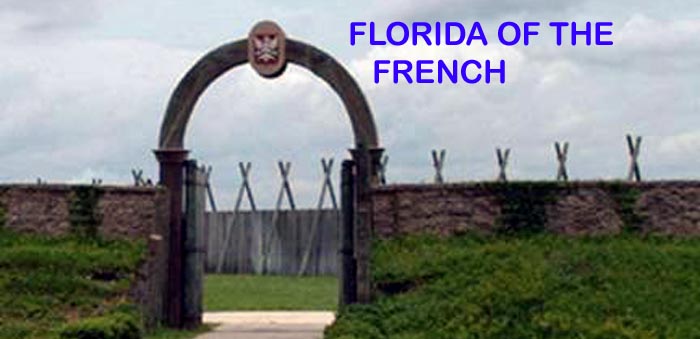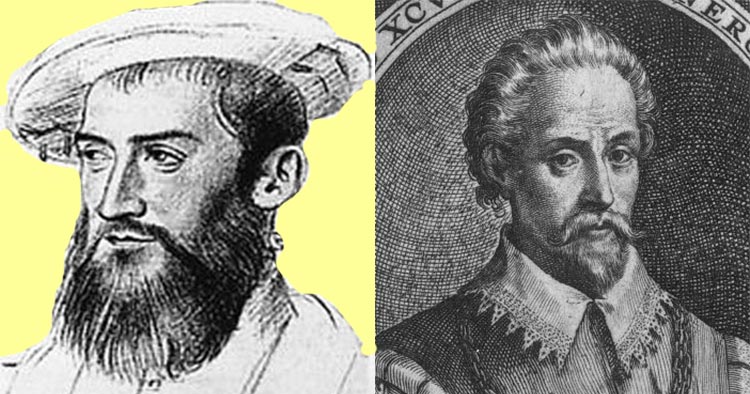
FLORIDA OF THE FRENCH
THE FOUNDING OF FORT CAROLINE ON THE ST JOHNS RIVER
THE FRENCH CHALLENGE.TO SPAIN Philip II's proclamation to desert the colonization of Florida had barely left his office when a new power in
Europe prepared to challenge Spain's
authority in Florida.
The challenge came from a group of French Protestants, called
Huguenots who had only recently
gained their religious liberty from the French Crown. After years of religious
conflict, dividing France
into two armed camps, these followers of the teachings of Martin Luther, were prepared to establish France as a
mercantile power.
Many
of the Huguenots were merchants and sailors. Their leader was Admiral Gaspard de
Coligny. Coligny was a clever statesman and a trusted maritime advisor
to the Bourbon king, Charles IX. Coligny convinced Charles IX that France's future success as a nation depended
upon competing with Spain
and Portugal
for American colonies. Charles' mother
Catherine de Medici, a staunch Catholic who was divided by her desire to
expand French colonization and her faith, warned Philip II that Coligny wanted
to overthrow Spain in the New World. Her report was an exaggeration, for even
Coligny realized France had
to avoid Spain's
developed colonies. Still Coligny's choice of developing a colony in Florida, so close to the Spanish gold fleets may open the
question of whether Coligny
wanted to confront Spain.
Five miles east of Jacksonville on the St. Johns River stands a replica of Fort Caroline.



The French Leaders: JEAN RIBAULT and RENE LAUDONNIERE
JEAN RIBAULT LEADER OF THE FRENCH
In 1562 Coligny selected France's
best seaman, JEAN
RIBAULT to lead France
into North America. Ribault
grew up in the seaport of Dieppe
and was an experienced sailor. His second-in-command was Rene de Laudonniere, the son of a
French explorer and an assistant to Admiral Coligny.
Using
sailing instructions from Verrazano's voyage of North America, Ribault reached the Florida
coast near Cape Canaveral on April 30, 1562.
He sailed northward to the mouth of a wide river the Spanish called "the St. Johns",
but which Ribault renamed "the River of May."
He landed on a small river island, which he called "Mayport."

Here Ribault constructed a five-sided column featuring a bronze
shield bearing the cost-of-arms of Queen Catherine, the very woman who had
opposed the mission. Curious Timucuans under Chief Saturiba
visited the Huguenot encampment. The French presented the Timucuans
with gowns of blue embroidery. In return, Saturiba
stocked the French with maize, beans, cucumbers, and fish. Ribault
wrote glowingly of the friendliness of the contact.
Returning
to Europe, Ribault stopped at the Broad River, near
present-day Parris Island, South Carolina. He called the spot "Port Royal"
and in complete disobedience with Coligny's orders not to start a settlement, Ribault built a log blockhouse, he named "Charlesfort." Here, fifty-eight years before the
Pilgrims, Ribault left thirty soldiers under Albert de la Pierria
When Ribault returned to Dieppe,
he was dismayed to discover religious conflict between Huguenots and Catholics
had erupted. He went to Queen Elizabeth
in England
in the hope of obtaining supplies for Charlesfort.
Instead, the English monarch arrested him for violating Spanish territory. In
reality, Elizabeth wanted England to challenge Spain. 

With Ribault in a London
prison, it was up to RENE LAUDONNIERE to rescue the Charlesfort colony. Unfortunately, the Spanish minister in London had told Philip II of the French colony in Spanish
claimed land and the Spanish sent out ships from Cuba. Unknown to all in Europe, the tiny garrison at Charlesfort
had revolted against Captain Pierra and constructed a
crude longboat and headed along the coast. An English fishing craft
miraculously rescued them. When the Spanish reached Charlesfort,
they found the blockhouse deserted.
Rene Laudonniere organized a 300 person expedition, which
included three warships, headed by the 300 ton galleon Islbel
of Honfleur .
His forces included rich noblemen and former criminals; Huguenots and Moors;
women and single men. It was a bad blend of people for a
aristocrat with limited leadership skills.
FORT CAROLINE
Rene Laudonniere arrived at Mayport, but elected to construct a triangular fort on a
small bluff on the southern bank of the St. Johns River, a few miles upstream.
He named the colony Fort Caroline
in honor of Charles IX, who gave the expedition his reluctant blessing.
Fort Caroline was an unusual colony. There was little
in buildings besides the fortifications, supply houses, and small cabins built
outside the walls. Not all the settlers were Huguenots. There were some Roman
Catholics. The colony included soldiers, tailors, brewers, an artist, a
physician, and an astronomer. What the colony lacked was a minister and enough
experienced soldiers. While the fort was protected by moats on the forest side,
an enemy could evaluate the interior defenses by controling
the high bluff adjacent to the fort.
 Laudonniere tried to govern the operation, but was not an
effective leader. There was neither gold nor silver to entice the adventurous.
Farming proved difficult. The restless young men stole the fort's longboat and
sailed out the mouth of the St. Johns
to plunder Spanish gold ships.
Laudonniere tried to govern the operation, but was not an
effective leader. There was neither gold nor silver to entice the adventurous.
Farming proved difficult. The restless young men stole the fort's longboat and
sailed out the mouth of the St. Johns
to plunder Spanish gold ships.
The
colony was in poor shape when English sea dog John Hawkins stopped by and supplied the settlers with food. He
warned Laudonniere that the Spanish knew of Fort Caroline.
When Hawkins returned to Europe, he warned
Coligny of the colony's disorder. Coligny sent Jean Ribault, recently released from
prison, to replace Laudonniere before the Spanish
arrived. Ribault left France in June of 1565 with a rescue mission of six hundred
men, women, and children.

PEDRO MENENDEZ de AVILES LEADER OF THE SPANISH
Philip II was indeed planning to remove the French
Huguenot colony from Florida.
Ironically copying the French example, the Spanish King discovered his choice
for leader in the prison of the Golden
Tower in Seville. Pedro Menendez de Aviles had been jailed by the House of Trade
for disobeying orders. Philip II nevertheless knew this former Captain General
of the West Indies would be the perfect adelantado
for Florida.
Pedro
Menendez de Aviles was a skilled sailor, a wealthy supporter of Spain, and a
staunch Roman Catholic, all qualities needed to take control of Florida.
In
August of 1565, Menendez's attack fleet reached the mouth of the St. Johns, only to
discover that Ribault's five ships were blocking the
entrance in an advantageous position. Menendez withdrew to a deep and protected
harbor he had seen on August 28, 1565, St.
Augustine's day. He started a camp in the place he
called "St.
Augustine", not knowing he would be starting the oldest
continuous settlement in the United
States.

Jean Ribault realized he had to be daring to confront the
Spanish so he set sail to attack the Spanish while they unloaded supplies.
Unfortunately for the daring Frenchman, a sudden storm pushed his fleet past St. Augustine's protected
harbor. Most of the French ships crashed on the Atlantic shore near present-day
Daytona Beach.
Menendez,
realizing the French were caught in a storm south of St. Augustine, decided to
start his own surprise attack, an overland march to Fort Caroline. He left his fleet
guarding the entrance to St. Augustine, while he
sent five hundred professional soldiers through the swamplands of Northeast Florida. Despite a driving
rain storm and waist deep water, the troops marched north for three days.
The
men thought their leader was insane, but Menendez's plan worked perfectly. He
had a French traitor as an informant. They reached Fort Caroline
in the early morning and discovered the fortress unprepared for any landside
attack. Laudonniere's fort was even lower than
surrounding bluffs so the Spanish could denote every French defensive position
and sentinel..
The
Spanish rushed the defenseless garrison on three sides. Most of the French were
not trained soldiers and quickly deserted their positions. Laudonniere
and artist Jacques Le Moyne, whose paintings of the Indians are important
today, fled to the coast with some fifty survivors. The Spanish killed 142
French before the survivors surrendered. The Spanish lost one soldier. Menendez
renamed the fort San Mateo. In 1591 Flemish printer and publisher Theodor de Bry engraved the paintings of Jacques Lemoyne, thus preserving a picture of the French in Florida.

MATANZAS INLET: LAST DAYS FOR THE FRENCH
Ribault's forces, crushed on the Daytona Beaches,
had no other option but to march northward in hopes of attacking St. Augustine. The effort
might have succeeded if they were not stopped at Matanzas Inlet, the southern
entrance to St. Augustine
Harbor. Without tools and
sufficient lumber, the French could not cross the waterway.
Menendez
found the worn French on the south side of the Inlet. Some rich Frenchmen
offered payment for their lives, but Menendez refused. He brought Ribault across the Inlet in a rowboat and accepted formal
surrender. Ten Frenchmen at a time were brought across the waterway, and with
their hands tied behind them, marched behind sand dunes to be executed.
When
it was Ribault's turn to die, he told Menendez he was
proud to be a Lutheran. Only ten Catholic French and six cabin boys were spared
from the ordeal. The Inlet became known as "Mantanzas" or "massacre"
Inlet.
Pedro
Menendez de Aviles had placed the Spanish flag at San Mateo
and St. Augustine and finally established a
Spanish foothold on the Florida
peninsula. He had promised Spain
he would spend his entire fortune to assure a successful colony. He would soon
realize, as Florida's first Spanish colonial Governor, that it would take that money and more to keep
Spanish Florida
operating.
The French would try some futile comebacks in later years. In 1717 they built Fort Crevecoeur ("Broken Heart") in Gulf County near present-day Beacon Hill but soon deserted the town. In 1719 they seized Pensacola, but returned the town six months later. In 1766 French Huguenots set up a village called Campbell Town in Escambia County, but gave up on the town.




![]()

![]()
![]() Laudonniere tried to govern the operation, but was not an
effective leader. There was neither gold nor silver to entice the adventurous.
Farming proved difficult. The restless young men stole the fort's longboat and
sailed out the mouth of the
Laudonniere tried to govern the operation, but was not an
effective leader. There was neither gold nor silver to entice the adventurous.
Farming proved difficult. The restless young men stole the fort's longboat and
sailed out the mouth of the ![]()
![]()

![]()